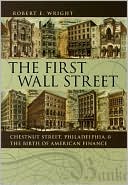

 |

|

The average rating for The First Wall Street: Chestnut Street, Philadelphia, and the Birth of American Finance based on 2 reviews is 4 stars.
Review # 1 was written on 2015-12-09 00:00:00 Carey Wolowski Carey WolowskiThis book perhaps tries to be too many things. Wright says that he wants this book to serve as an introduction to contemporary finance, and to its terminology about yields, dividends, preferred shares, and the like. But of course the terminology and habits of the early 19the century don't exactly provide a sure guide to those in the 21st. And the chatty tone of this introduction can grate ("Columbia was getting strong enough to kick John Bull's butt"). The book, published back in 2005, also tries to be an argument for the wonders and benefits of financial innovation, but this can ring a little hollow in the wake of the financial crisis. Even if one is convinced by most of Wright's arguments about the benefits, and I am, they are usually just that, arguments, asserted without much proof. Finally, the book is at its best when it makes a case for the forgotten primacy of Philadelphia in the financial world. Philadelphia, with the help of Benjamin Franklin, of course created the first fire insurance plan, the Philadelphia Contributorship, in 1752. But they also had the first life insurance plans, in 1759, for Presbyterian ministers, and marine insurance underwriters, started by "Old Square Toes," Thomas Willing in 1757. After the revolution, the first commercial bank in the United States, the Bank of North America, was established in Philadelphia in 1781, followed of course by the two national Banks of the United States. Philadelphia also had the first savings bank (The Philadelphia Savings Fund Society), and the first building and loans, which explains why Philadelphia became a "city of homes." Wright also shows that historians have underestimated the financial importance of locating, and keeping, the first US Mint in Philadelphia, despite its innumerable scandals and failure to operate successfully until the 1850s. Yet there are two startling absences in this book, the Philadelphia Stock Exchange and the New York Stock Exchange. Wall Street is, of course, identified with the latter, and one would think Wright in this book would try to identify Chestnut Street with the former, but both hardly make an appearance. Wright says that Philadelphia's formed shortly before New York's famous 1792 Buttonwood agreement, but that it didn't really get going until the 1830s, and always lagged behind New York's. It made me wonder why "Wall Street" surged so far ahead, and Wright in this book just doesn't give a solid answer. |
Review # 2 was written on 2008-09-22 00:00:00 Beth Smith Beth SmithSuspenseful! I didn't think you could say that about a book on history, since we all know the ending: we have banks, and a stock market, "Wall Street", etc. But leaning how it all started in Philadelphia (and was eventually continued in NYC) was really interesting. Looking forward to more from this author. |
CAN'T FIND WHAT YOU'RE LOOKING FOR? CLICK HERE!!!